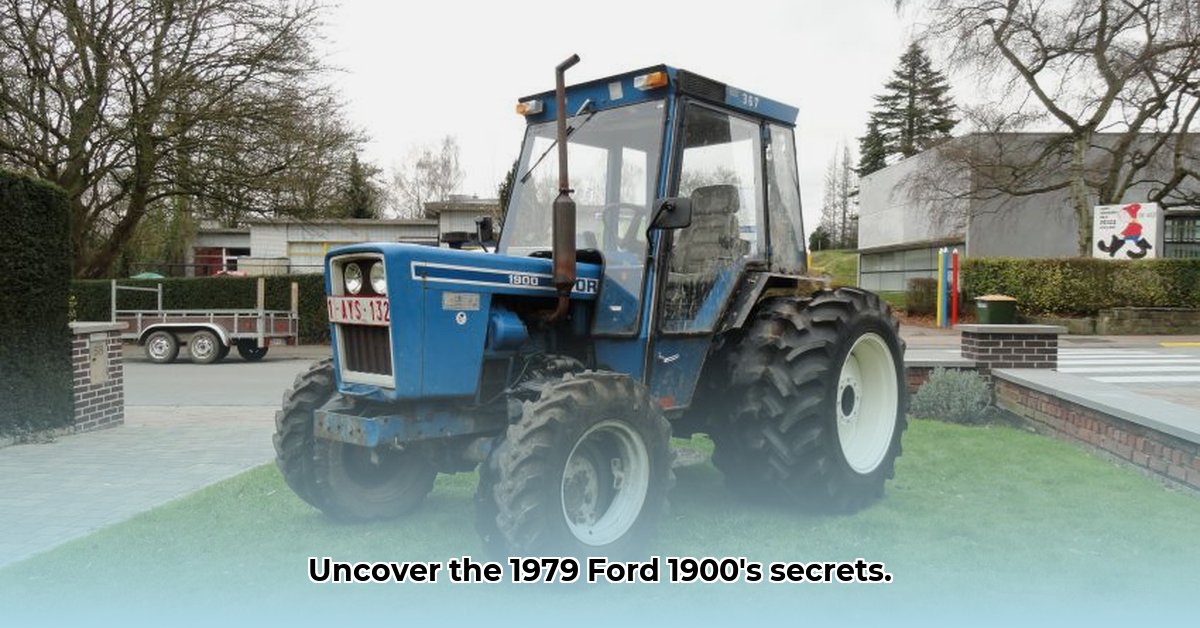
The 1979 Ford 1900 tractor, a compact workhorse built by Shibaura and marketed by Ford, represents a fascinating chapter in agricultural history. This article provides a comprehensive overview of its technical specifications, historical context, operational characteristics, and modern relevance, offering insights for both seasoned farmers and tractor enthusiasts. For more information on Ford tractors, see this helpful resource: Ford Tractor Info.
Technical Specifications: A Detailed Examination
Determining the precise specifications for the 1979 Ford 1900 requires careful consideration of various sources. Discrepancies often arise due to differing measurement units and reporting methods. The table below summarizes key specifications, noting areas of variation:
| Specification | Source A | Source B | Notes |
|---|---|---|---|
| Manufacturer | Shibaura | Shibaura | Joint venture: Shibaura manufactured, Ford distributed. |
| Engine Model | Unspecified | Shibaura LEM853 | One source provides more detail than the other. |
| Engine Horsepower (Gross) | 30 hp | 30.5 hp | Minor variations are common across different sources and testing methods. |
| Engine Horsepower (PTO) | 26.88 hp | 27.2 hp | PTO (Power Take-Off) horsepower is always less than gross horsepower. |
| Weight | 2689-2922 lbs | 1247 kg (approximately 2750 lbs) | Weight varies based on configuration and attachments. |
| Fuel Tank Capacity | 7.7 gal | 29.0 L (approximately 7.6 US gal) | Unit conversion differences account for minor variations. |
| Lift Capacity | 3,813 lbs | 1,729 kg (approximately 3,813 lbs) | Excellent agreement; differing units used. |
| PTO Type | 540 rpm | 540 rpm | The standard 540 rpm PTO speed is common for farm implements. |
| Wheelbase (2WD) | 63 inches | Unspecified | Source B omitted this dimension. |
| Wheelbase (4WD) | 64.2 inches | Unspecified | Source B omitted this dimension. |
| Length | Unspecified | 3,020 mm (approximately 119 inches) | Dimensions vary depending on attachments. |
| Height | Unspecified | 2,190 mm (approximately 86 inches) | Dimensions vary depending on attachments. |
These variations underscore the importance of cross-referencing information when researching vintage machinery. Was the difference in reported weight due to optional equipment? Further investigation might reveal the answer.
Historical Context: The Ford 1900 in its Era
The Ford 1900 emerged during a period of significant agricultural transformation. While larger, more powerful tractors were gaining popularity, the 1900, with its compact size and efficient engine, filled a vital niche for smaller farms and specialized tasks. Its maneuverability in tighter spaces proved advantageous, even within the context of the growing mechanization of agriculture.
Operational Characteristics: Capabilities and Applications
The Ford 1900's three-point hitch system enabled the use of numerous implements, expanding its versatility beyond plowing and tilling. Farmers could adapt the tractor to various tasks throughout the year, including mowing, hay baling, and even snow removal (with appropriate attachments). This adaptability significantly contributed to its continued popularity during its production run.
Modern Relevance: Value, Parts, and Potential
The Ford 1900 continues to attract interest, finding a place in agricultural restoration projects, small-scale farming, and hobby farming. However, prospective owners must consider several factors:
- Parts Availability: Finding replacement parts can be challenging and expensive, requiring resourceful searching and a network of suppliers.
- Maintenance Costs: Older machinery requires dedicated upkeep and routine maintenance, potentially involving specialized knowledge or expertise.
- Power Limitations: Its horsepower is moderate compared to modern tractors, limiting its suitability for large-scale operations.
Despite these challenges, the Ford 1900's dependable nature and potential for restoration make it a rewarding investment for dedicated enthusiasts. Many find the restoration process itself a fulfilling endeavor.
Maintaining Your Ford 1900: A Practical Guide
Proper maintenance is key to extending the life of your Ford 1900. This is crucial for preserving its historical and operational value. Regular checks and prompt attention to problems will help prevent costly repairs. The following steps comprise a good starting point for maintaining your vintage tractor:
- Regular Fluid Changes: Change engine oil, transmission fluid, and hydraulic fluid according to the manufacturer's recommendations.
- Fuel System Cleanliness: Use clean fuel and maintain the fuel system to prevent issues.
- Engine Tune-Ups: Regular tune-ups ensure optimal performance and prevent larger problems.
- Component Inspections: Regularly inspect belts, hoses, and other critical components for wear and tear.
- Tire Maintenance: Maintain proper tire inflation and inspect tires regularly.
Preventive maintenance is a cost-effective strategy, significantly reducing the chance of major repairs down the line.
Conclusion: A Lasting Impression
The 1979 Ford 1900 tractor carved a notable place in agricultural history, offering a blend of reliability and compact design. While challenges exist regarding parts and maintenance, its continued appeal to collectors, enthusiasts, and small-scale farmers serves as a testament to its enduring legacy. Its story exemplifies the lasting value of well-engineered machinery.